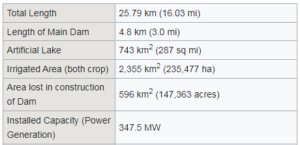In news- The Forest and Environment Department of Odisha is all set to begin ‘Island Odyssey’ and ‘Hirakud Cruise’ ecotourism packages for tourists to islands inside the reservoir. This package also includes Cattle island.
About Cattle island
- Cattle Island is nothing but a sub-merged hill. Prior to the Dam construction, it was a developed village.
- The specialty about the island is that it is inhabited by the cattle group of animals.
- ‘Cattle island’, one of three islands in the Hirakud reservoir, has been selected as a sight-seeing destination.
- When large numbers of people were displaced from their villages when the Hirakud dam was constructed on the Mahanadi river in the 1950s, villagers could not take their cattle with them.
- They left their cattle behind in deserted villages.
- As the area started to submerge following the dam’s construction, the cattle moved up to Bhujapahad, an elevated place in the Telia Panchayat under Lakhanpur block of Jharsuguda district.
- Subsequently named ‘Cattle island’, it’s surrounded by a vast sheet of water.
- The cattle in this show wild characteristics.
- They are not ferocious, but shy. If a person comes near, the animals just run away.
Island bat
- There is an “island of bats”, also within the reservoir, just 1 km away from the Debrigarh ecotourism project.
- It is the habitat of hundreds of bats.
Hirakud Dam
- Soon after India got freedom, the Hirakud dam construction began.
- It is built across the Mahanadi River, about 15 kilometres from Sambalpur in the state of Odisha in India.
- It is the longest dam in the world. Behind the dam extends a lake, Hirakud Reservoir, 55 km (34 mi) long.

- The bulk of Hirakud dam contains earth, concrete and masonry materials.
- From horizon to horizon the reservoir forms the largest artificial lake in Asia with an area of 746 Sq.Kms. and a shore line over 640 Kms.
- It is one of the first major multipurpose river valley projects started after India’s independence.
- After the devastating floods of 1936, Sir M. Visveswararya proposed a detailed investigation for storage reservoirs in the Mahanadi basin to tackle the problem of floods in the Mahanadi delta.
- The Central Waterways, Irrigation and Navigation Commission took up the work.
- On 15 March 1946, Sir Hawthorne Lewis, the Governor of Odisha, laid the foundation stone of the Hirakud Dam.
- A total of 73,923 hectares of land was submerged.
- This included 49,920 ha of agricultural land and 24,003 ha of government land, including forest land.
- A total of 111 villages were fully submerged, out of which 108 were in Odisha.
- The Debrigarh wildlife sanctuary is located near Hirakud dam which is bounded on the east and north by the Hirakud reservoir.
















